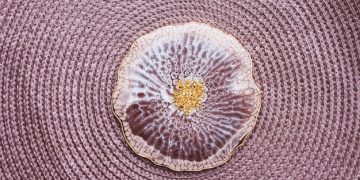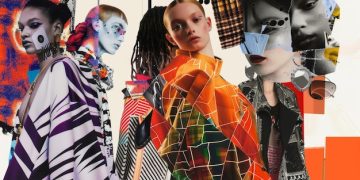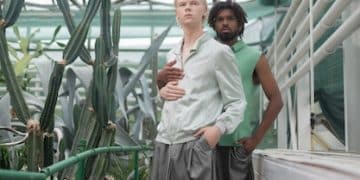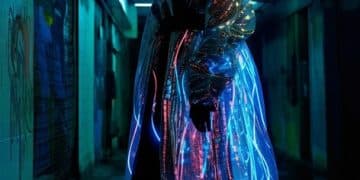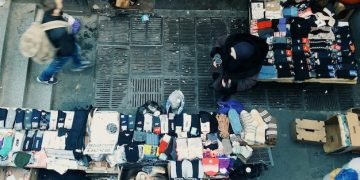Underground Fashion Fabrics: Sustainable Materials To Dominate 2025

As underground fashion evolves, sustainable fabrics are set to redefine its landscape by 2025, with innovative materials like pineapple leaf fiber, mushroom leather, and recycled ocean plastic leading the charge towards eco-conscious and avant-garde designs.
The underground fashion scene is constantly evolving, and a key area of focus for 2025 will be on underground fashion fabrics: Which Sustainable Materials Will Dominate 2025?. Discover the innovative and eco-friendly textiles that are poised to revolutionize the industry and push the boundaries of style.
Sustainable Fabrics Reshaping Underground Fashion
Sustainable fabrics are no longer a niche trend; they are becoming a core element of the underground fashion movement. The drive to reduce environmental impact and embrace ethically sourced materials has led to a surge in innovative fabrics that challenge traditional notions of style and luxury.
These fabrics not only offer eco-friendly alternatives but also provide unique textures, aesthetics, and functional properties that appeal to cutting-edge designers and consumers. As we look ahead to 2025, several sustainable materials are expected to take center stage in the underground fashion scene.
The Rise of Eco-Conscious Consumers
The growing awareness of environmental issues has fueled a demand for sustainable products across various industries, and fashion is no exception. Consumers are becoming more conscious of the impact their clothing choices have on the planet, leading them to seek out brands and designers that prioritize sustainability.
This shift in consumer behavior has created a market opportunity for underground fashion labels that embrace eco-friendly practices. By using sustainable fabrics and promoting ethical production methods, these brands can attract a loyal customer base that values both style and social responsibility.
Innovations in Textile Recycling
Recycling is a crucial component of sustainable fashion, and innovative technologies are constantly being developed to transform textile waste into new fabrics. From repurposing pre-consumer scraps to breaking down post-consumer garments, recycling offers a way to reduce landfill waste and conserve resources.
According to a report by the Ellen MacArthur Foundation, less than 1% of textiles are currently recycled into new clothing. However, with advancements in recycling technology and increased consumer demand, this figure is expected to rise significantly by 2025.
- Chemical Recycling: Breaks down fibers to their molecular level, allowing for the creation of virgin-quality materials.
- Mechanical Recycling: Shreds and reprocesses fabrics into new yarns, often blended with other fibers.
- Upcycling: Transforms discarded materials into higher-value products, adding a creative twist to recycling.
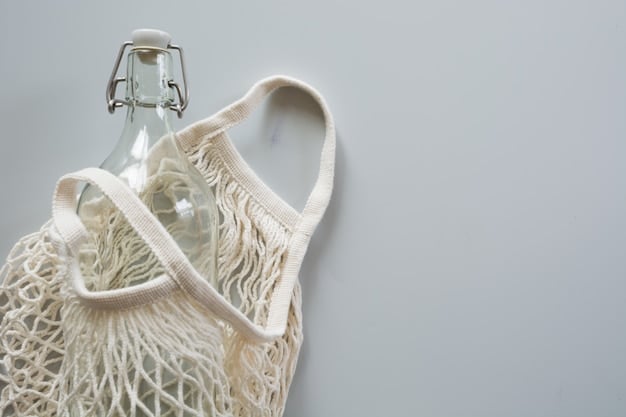
In conclusion, the integration of sustainable fabrics is not just a trend but a necessary evolution in the underground fashion world. The demand for eco-friendly options, coupled with advancements in recycling and material innovation, sets the stage for a future where style and sustainability coexist harmoniously.
Emerging Plant-Based Fabrics
Plant-based fabrics are gaining traction as sustainable alternatives to conventional textiles like cotton and polyester. These fabrics are derived from renewable resources and can be produced with minimal environmental impact.
From agricultural waste to fast-growing crops, a variety of plant materials are being transformed into innovative textiles that offer unique properties and aesthetics. As technology advances, we can expect to see even more plant-based fabrics emerge in the underground fashion scene.
Pineapple Leaf Fiber (Piñatex)
Piñatex is a leather alternative made from pineapple leaf fibers, a byproduct of the pineapple harvest. This innovative material is durable, versatile, and biodegradable, making it a sustainable choice for clothing, accessories, and footwear.
Developed by Ananas Anam, Piñatex offers a solution to the environmental problems associated with animal leather production, such as deforestation and greenhouse gas emissions. It also provides an additional income stream for pineapple farmers in developing countries.
Mushroom Leather (Mylo)
Mylo is a leather alternative made from mycelium, the root structure of mushrooms. This bio-based material is grown in controlled environments using minimal resources and can be processed into a soft, supple fabric that mimics the look and feel of traditional leather.
Produced by Bolt Threads, Mylo offers a sustainable alternative to animal leather and synthetic options like polyurethane (PU) leather. It is also biodegradable and free from harmful chemicals, making it a safe and eco-friendly choice for fashion brands.
- Rapid Growth: Mycelium can be grown in a matter of weeks, compared to the years it takes to raise livestock for leather production.
- Minimal Resources: Mycelium requires minimal water, energy, and land to grow, reducing its environmental footprint.
- Customizable: Mycelium can be engineered to have different textures, thicknesses, and colors, offering designers a wide range of options.
In summary, plant-based fabrics like Piñatex and Mylo are paving the way for a more sustainable and ethical fashion industry. These innovative materials offer viable alternatives to conventional textiles and have the potential to reshape the underground fashion landscape by 2025.
Ocean Plastics Transformed into Fashion
The growing problem of ocean plastic pollution has spurred a wave of innovation in the fashion industry, with designers and brands seeking to transform discarded plastic waste into valuable textiles.
By intercepting plastic waste before it reaches the ocean or collecting it from coastal areas, these initiatives not only help clean up the environment but also create new materials for clothing, accessories, and footwear. As awareness of plastic pollution continues to grow, we can expect to see more ocean plastic fabrics emerge in the underground fashion scene.
Recycled PET Fabrics
Polyethylene terephthalate (PET) is a type of plastic commonly used in beverage bottles and food packaging. Recycled PET fabrics are made by melting down PET waste and spinning it into new fibers that can be woven or knitted into textiles.
These fabrics are durable, lightweight, and can be used for a variety of applications, including clothing, bags, and outdoor gear. By using recycled PET fabrics, brands can reduce their reliance on virgin plastic and help divert waste from landfills and oceans.
Ocean Cleanup Initiatives
Several organizations are dedicated to cleaning up ocean plastic and transforming it into valuable materials. The Ocean Cleanup, for example, is developing technologies to remove plastic waste from the Great Pacific Garbage Patch and other polluted areas.
Other initiatives, such as Parley for the Oceans, partner with brands to create products made from ocean plastic, raising awareness of the issue and supporting cleanup efforts. These collaborations demonstrate the potential for fashion to be a force for environmental good.
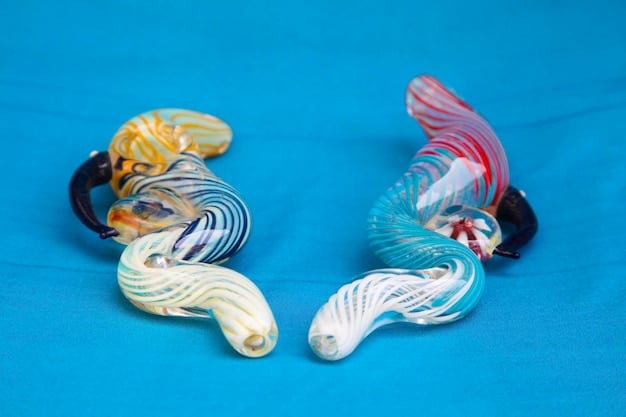
- Waste Reduction: Diverts plastic waste from landfills and oceans, reducing pollution and conserving resources.
- Resource Efficiency: Reduces the need for virgin plastic production, saving energy and raw materials.
- Brand Value: Enhances brand image and attracts environmentally conscious consumers.
In conclusion, the transformation of ocean plastics into fashion is a promising approach to tackling plastic pollution and creating sustainable textiles. As technology and awareness improve, these materials will likely play a significant role in the future of underground fashion.
Bio-Based and Biodegradable Materials
Bio-based and biodegradable materials are derived from renewable resources and can decompose naturally at the end of their lifespan, reducing their environmental impact. These fabrics are gaining popularity in the fashion industry as consumers and brands seek more sustainable alternatives to conventional textiles.
From agricultural byproducts to innovative biopolymers, a variety of materials are being developed to create fabrics that are both eco-friendly and high-performing. As research and development continue, we can expect to see even more bio-based and biodegradable materials emerge in the underground fashion scene.
Tencel (Lyocell)
Tencel, also known as Lyocell, is a fiber made from sustainably sourced wood pulp. This fabric is produced in a closed-loop process that recycles water and solvents, minimizing its environmental impact. Tencel is soft, breathable, and absorbent, making it a popular choice for clothing and home textiles.
Produced by Lenzing, Tencel offers a sustainable alternative to conventional rayon and viscose fibers, which are often made from unsustainable sources and processed with harmful chemicals. It is also biodegradable and compostable, making it a truly eco-friendly material.
Hemp Fabrics
Hemp is a fast-growing crop that requires minimal water and pesticides, making it a sustainable alternative to cotton. Hemp fabrics are strong, durable, and naturally resistant to mold and mildew. They also have a unique texture and aesthetic that appeals to designers and consumers.
Hemp fabrics were used for centuries before being largely replaced by cotton and synthetic fibers. However, with growing awareness of sustainability issues, hemp is experiencing a resurgence in popularity and being used in a wide range of clothing and accessories.
In closing, bio-based and biodegradable materials like Tencel and hemp offer viable solutions for creating more sustainable and eco-friendly fashion. Their unique properties and minimal environmental impact make them promising choices for the underground fashion industry.
The Role of Technology in Sustainable Fabric Development
Technology plays a crucial role in the development of sustainable fabrics, enabling scientists and engineers to create innovative materials with enhanced performance and reduced environmental impact.
From precision agriculture to advanced textile processing, technology is helping to optimize the production of sustainable fabrics and make them more accessible to designers and consumers. As technology continues to advance, we can expect to see even more breakthroughs in sustainable fabric development.
3D Printing of Fabrics
3D printing, also known as additive manufacturing, is a technology that allows for the creation of three-dimensional objects from digital designs. In the fashion industry, 3D printing is being used to create custom-fit clothing, intricate embellishments, and even entire garments from sustainable materials.
3D printing offers several advantages over traditional textile manufacturing, including reduced waste, on-demand production, and the ability to create complex designs with minimal labor. As the technology becomes more affordable and accessible, we can expect to see it play a larger role in the underground fashion scene.
Nanotechnology Applications
Nanotechnology involves the manipulation of materials at the atomic and molecular level to create new properties and functionalities. In the fashion industry, nanotechnology is being used to develop fabrics with enhanced performance characteristics, such as water resistance, stain resistance, and UV protection.
Nanotechnology can also be used to create fabrics with antimicrobial properties, reducing the need for frequent washing and extending the lifespan of garments. As research and development continue, we can expect to see even more innovative applications of nanotechnology in sustainable fabric development.
- Precision Agriculture: Uses sensors and data analytics to optimize crop yields and reduce resource consumption.
- Closed-Loop Production: Recycles water and solvents, minimizing waste and environmental impact.
- Advanced Dyeing Techniques: Reduces water and chemical usage in the dyeing process.
Ultimately, technology is essential for driving innovation and sustainability in the fashion industry. From 3D printing to nanotechnology, these tools are enabling the creation of eco-friendly materials with enhanced performance and unique aesthetic qualities.
Challenges and Opportunities in Sustainable Fabric Adoption
While sustainable fabrics offer numerous benefits, their adoption in the fashion industry is not without its challenges. Overcoming these obstacles and capitalizing on emerging opportunities will be crucial for the widespread integration of sustainable materials in the underground fashion scene.
From cost and availability to consumer perception and supply chain transparency, several factors can impact the adoption of sustainable fabrics. By addressing these challenges and embracing innovative solutions, the fashion industry can pave the way for a more sustainable future.
Cost and Availability
Sustainable fabrics are often more expensive than conventional textiles due to higher production costs and limited availability. This can be a barrier for small brands and designers who may struggle to afford sustainable options or find reliable suppliers. However, as demand for sustainable fabrics increases and production processes become more efficient, costs are expected to decrease and availability is expected to improve.
Government incentives and subsidies can also play a role in leveling the playing field and making sustainable fabrics more accessible to businesses of all sizes. Additionally, collaborations between brands and suppliers can help to create economies of scale and reduce costs.
Consumer Perception and Marketing
Consumer perception of sustainable fabrics can also impact their adoption in the fashion industry. Some consumers may associate sustainable materials with lower quality or unappealing aesthetics. Overcoming these misconceptions requires effective marketing and education efforts.
Brands can showcase the unique properties and aesthetic qualities of sustainable fabrics through compelling storytelling and visually appealing designs. Certifications and labels can also help to assure consumers of the sustainability and ethical sourcing of materials.
In conclusion, while challenges exist in the adoption of sustainable fabrics, addressing these hurdles and capitalizing on opportunities will ensure the advancement of sustainable materials in the fashion industry.
| Key Point | Brief Description |
|---|---|
| ♻️ Recycling Innovation | Advanced recycling techniques transform textile waste into new, high-quality fabrics. |
| 🍍 Piñatex Fiber | Leather alternative from pineapple leaf fibers, offering a sustainable and versatile option. |
| 🌊 Ocean Plastic | Recycled PET fabrics derived from ocean plastic waste, reducing pollution and conserving resources. |
| 🍄 Mushroom Leather | Mylo is a biodegradable, sustainable leather alternative made from mycelium. |
FAQ Section
▼
A sustainable fabric minimizes environmental impact through its entire lifecycle, considering factors like resource use, pollution, and biodegradability. These fabrics often utilize recycled or renewable materials.
▼
Pineapple leaf fiber, or Piñatex, uses agricultural waste, reducing landfill burden and providing additional income for farmers. It also minimizes the need for animal-derived or synthetic leather alternatives.
▼
Recycled ocean plastics help clean up marine environments, reduce plastic pollution, and lessen the demand for virgin plastic production, promoting a circular economy.
▼
Innovation drives the creation of new materials, improves production processes, and enhances fabric performance, making sustainable options more competitive and accessible in the fashion industry.
▼
Consumers can support sustainable fabrics by choosing brands that prioritize eco-friendly materials, demanding transparency in the supply chain, and educating themselves about sustainable options available.
Conclusion
As we approach 2025, the integration of sustainable fabrics into underground fashion is set to revolutionize the industry. Innovations in materials like pineapple leaf fiber, mushroom leather, and recycled ocean plastic are driving a shift toward eco-conscious designs. By embracing these advancements, the fashion world can pave the way for a more environmentally responsible and stylish future, appealing to a growing base of ethically-minded consumers.
